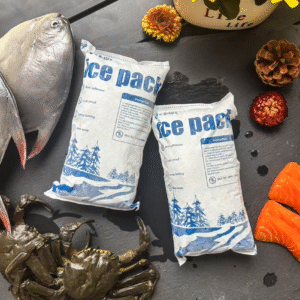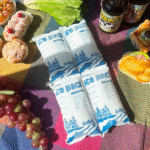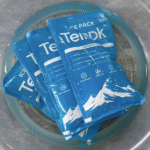Expédition de produits sensibles à la température, comme les produits pharmaceutiques, nourriture, and biotech materials, demands reliable cooling methods to ensure their integrity during transit. Dry ice pack sheets have gained popularity in the cold chain logistics industry due to their superior cooling capabilities and ease of use. These sheets are an essential solution, providing a safe and efficient cooling option for goods that require strict temperature control. Dans cet article, we explore the benefits of dry ice pack sheets, Comment ils fonctionnent, best practices for usage, et l'avenir de la logistique de la chaîne du froid.
-
Feuilles de glace carbonique provide long-lasting cooling without any moisture, essential for preserving temperature-sensitive products.
-
They are versatile and used across multiple industries, y compris la nourriture, médicaments, et biotechnologie.
-
Proper storage and handling are critical to ensure safety and efficiency in cold chain logistics.
-
Meilleures pratiques d’utilisation des feuilles de glace carbonique involve correct storage, dimensionnement, and regulatory compliance to guarantee safe and effective shipments.
Pourquoi les feuilles de glace carbonique sont-elles essentielles pour l'expédition sous la chaîne du froid?
Dry ice pack sheets are invaluable in maintaining temperature control during shipping, offering multiple advantages over traditional cooling methods. Contrairement aux packs de gel ou à la glace ordinaire, la neige carbonique se sublime directement d'un solide à un gaz, ne laissant aucune humidité derrière. This characteristic is especially beneficial for products that could be damaged by excess liquid, such as medicines, vaccins, et aliments surgelés.
Dry ice pack sheets are available in various forms, making them adaptable for different packaging needs. They are particularly useful for maintaining sub-zero temperatures, ensuring that perishable items like vaccines, échantillons biologiques, and frozen meals remain safely preserved throughout long-distance shipments.
What Makes Dry Ice Pack Sheets Stand Out in Cold Chain Logistics?
Dry ice pack sheets are often preferred over other cooling methods due to their high cooling efficiency, longue durée, et flexibilité. These sheets are capable of maintaining a constant low temperature for extended periods, making them ideal for overnight and long-distance shipping. Their lightweight design reduces the overall weight of shipments, which helps to lower transportation costs.
Pre-made sheets are commonly available, which simplifies integration into shipping kits. This convenience allows businesses to scale their shipments according to demand and ensure that their products are properly cooled.
Comment fonctionnent les feuilles de glace sèche?
Dry ice pack sheets are composed of solid carbon dioxide (Co₂). When placed in an insulated shipping container, the dry ice begins to sublimate, transitioning from a solid to a gas. This process provides a continuous cooling effect that helps maintain the temperature of sensitive products. The absence of moisture ensures that items remain dry, preventing spoilage—an essential factor when shipping frozen foods or biological materials.
Comparison of Dry Ice Pack Sheets with Other Cooling Methods
| Propriété | Feuilles de pack de glace sèche | Gel Packs/Ice | CO₂ Dry Ice | Matériaux à changement de phase (PCMS) |
|---|---|---|---|---|
| Durée de refroidissement | 12-72 heures | 4-24 heures | 48-96 heures + | 24-96 heures |
| Teneur en humidité | Aucun (Limères soudantes) | Liquid water (Fusion) | Aucun (Limères soudantes) | Varie (depends on formulation) |
| Idéal pour | Expédition à longue distance | Courte distance | Deep-freezing | Contrôle précis de la température |
| Efficacité pondérale | Léger | Lourd/à base d'eau | Lourd | Modéré |
Best Practices for Using Dry Ice Pack Sheets in Shipping
To ensure that dry ice pack sheets perform optimally, it’s essential to follow best practices for handling, stockage, et transport.
1. Proper Storage Before Use
Conservez la glace carbonique dans un endroit bien ventilé, loin des sources de chaleur. Insulated containers should be used to minimize sublimation, ensuring that cooling capacity is maintained. Avoid airtight containers to prevent the buildup of pressure, which could cause accidents.
2. Correct Usage in Packaging
Use the correct amount of dry ice depending on the shipment’s duration and the quality of insulation. Overuse of dry ice can lead to overly cold conditions, potentially damaging certain products, such as some pharmaceuticals that need to stay within specific temperature ranges. Make sure the packaging is secure and has enough room for ventilation to avoid dangerous gas buildup.
3. Considérations de sécurité
Manipuler la glace sèche avec soin, always using insulated gloves to prevent frostbite. Packaging should be clearly labeled with safety information to alert handlers of potential hazards. Comme la glace sèche sublime dans le dioxyde de carbone, ensure the packaging is vented, particularly for air transport, to prevent suffocation risks in confined spaces.
Étude de cas: A Pharmaceutical Success Story
A major pharmaceutical company transitioned from gel packs to dry ice for shipping vaccines. Le résultat? UN 30% reduction in cooling-related shipping delays and enhanced temperature control across their supply chain. By switching to dry ice pack sheets, they ensured their shipments remained consistently within the required temperature range, reducing spoilage and increasing overall efficiency.
Benefits of Using Dry Ice Pack Sheets
Enhanced Temperature Control for Sensitive Products
Dry ice offers a consistent and long-lasting cooling effect, essential for preserving temperature-sensitive products like food, médicaments, et les produits biotechnologiques. Contrairement aux packs de glace ou de gel traditionnels, dry ice maintains sub-zero temperatures for up to 72 heures ou plus, providing superior protection during long shipments.
Solution écologique
Dry ice pack sheets are environmentally friendly as they sublimate into carbon dioxide gas, leaving no waste behind. This makes them an excellent choice for businesses seeking sustainable solutions while maintaining product quality during transportation.
Rentabilité
Pour les expéditions plus longues, dry ice is often more cost-effective. The ability to maintain a cold temperature for extended periods eliminates the need for additional cooling methods, such as refrigerated containers, which can significantly reduce transportation costs.
Considérations clés lors de l'expédition avec de la glace carbonique
When integrating dry ice into your shipping processes, keep the following key factors in mind to ensure safe and efficient deliveries:
-
Qualité de l'isolation: The insulation quality of your shipping container will greatly impact the performance of dry ice pack sheets. High-quality insulation helps maintain low temperatures and prevents premature sublimation of the dry ice.
-
Règlements d'expédition: Comply with international regulations, such as IATA guidelines, lors de l'expédition de glace carbonique. Make sure to properly label and package shipments containing dry ice to avoid compliance issues.
-
Regulatory Guidelines: Follow all regulatory guidelines for safe and compliant dry ice use, including proper labeling and handling to ensure the safety of personnel and products during transit.
Trends and Future Developments in Dry Ice Shipping
Advancements in Dry Ice Packaging
Packaging innovations are making it easier to ensure that shipments remain at optimal temperatures throughout the transit process. Real-time temperature monitoring systems are now being integrated into shipping containers, allowing for more precise tracking of temperature variations during transport.
Focus on Sustainability in Cold Chain Logistics
The cold chain industry is increasingly focusing on reducing its environmental footprint. With an emphasis on reducing waste and using renewable energy, dry ice is seen as an eco-friendly cooling solution that fits perfectly within the industry’s growing sustainability efforts.
FAQ
Q1: How long can dry ice pack sheets keep products cold during shipping?
Dry ice pack sheets can maintain cold temperatures for 12-72 heures, depending on the quantity used and the insulation quality of the shipping container.
Q2: La glace carbonique peut-elle être expédiée par avion?
Oui, la glace carbonique est généralement expédiée par avion. Cependant, air shipments require specific packaging and labeling, as well as compliance with air transport regulations.
Conclusion
Dry ice pack sheets are an essential tool in the cold chain logistics industry. They offer a reliable, rentable, and eco-friendly solution for maintaining temperature-sensitive shipments. By following best practices for storage, manutention, and usage, businesses can optimize their cold chain logistics operations and ensure their products reach their destination safely and efficiently.
Étapes suivantes:
-
Ensure proper sizing and storage of dry ice pack sheets based on your shipping requirements.
-
Restez à jour avec 2025 cold chain trends to maximize efficiency.
-
Improve insulation and packing strategies to enhance temperature stability during long-distance shipments.
À propos du tempk:
Tempk se spécialise dans la fourniture de solutions de logistique avancée en chaîne du froid, y compris des feuilles de glace sèche haute performance. Avec un engagement envers la qualité et la durabilité, we help businesses streamline their temperature-sensitive shipping processes.
Contact us today for tailored cold chain solutions that suit your shipping needs.
























